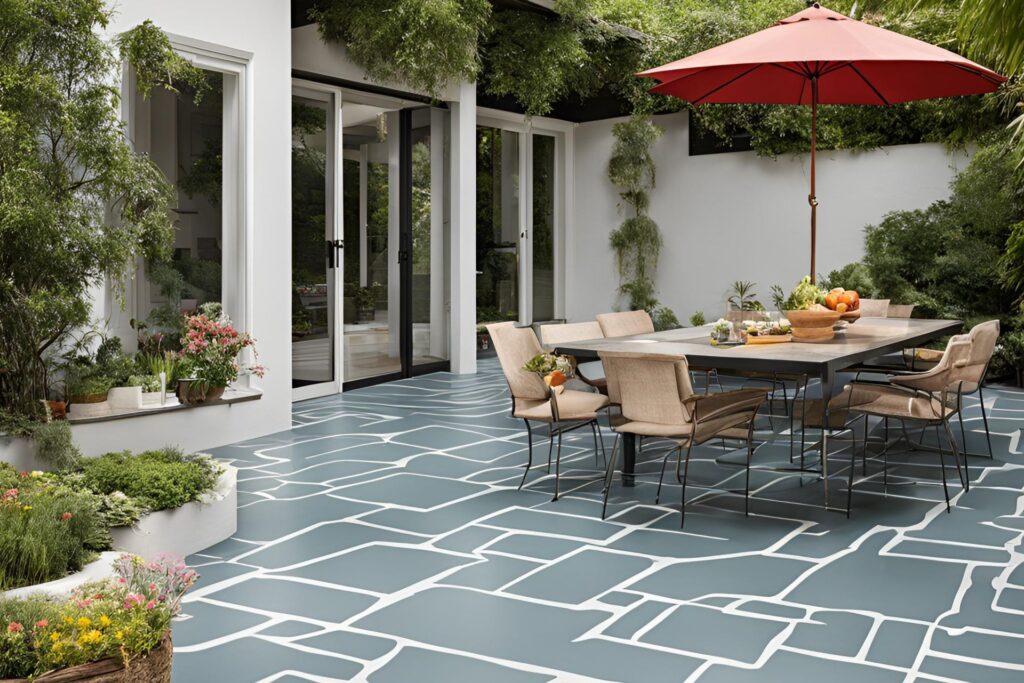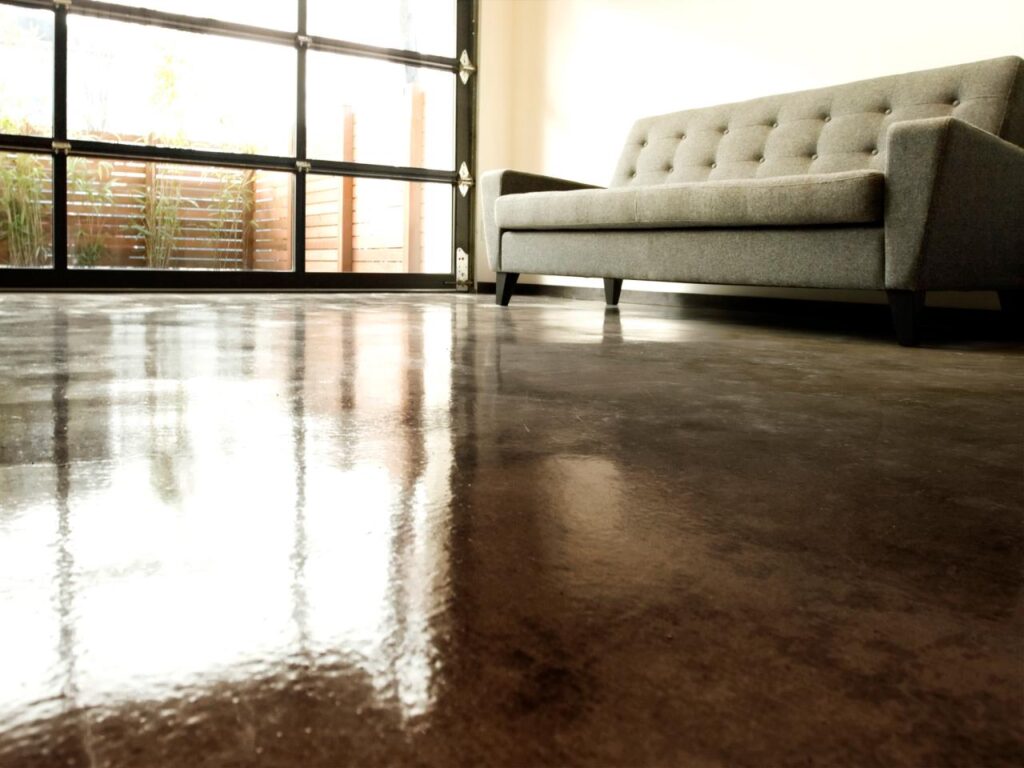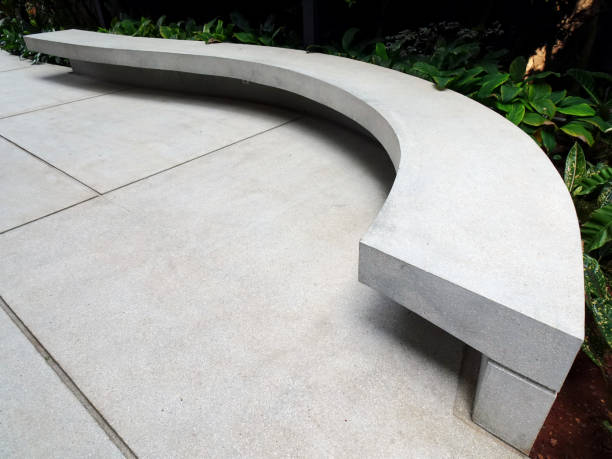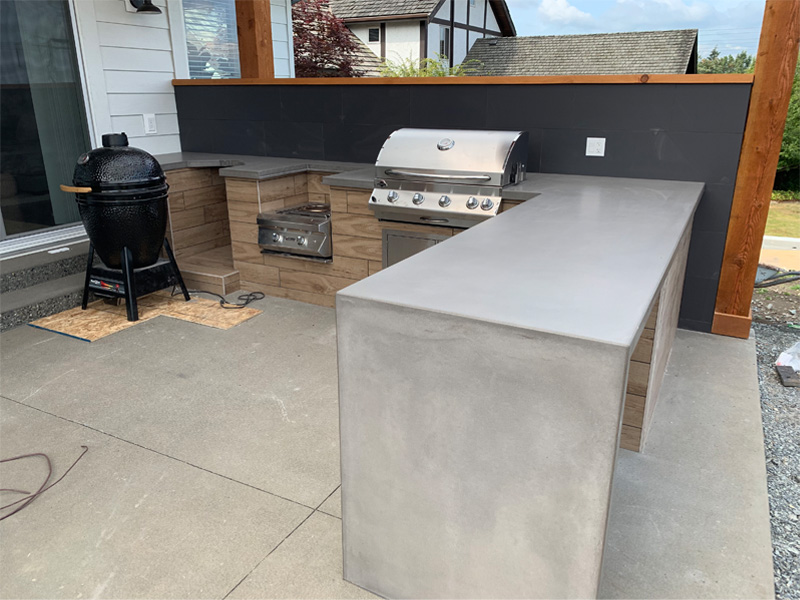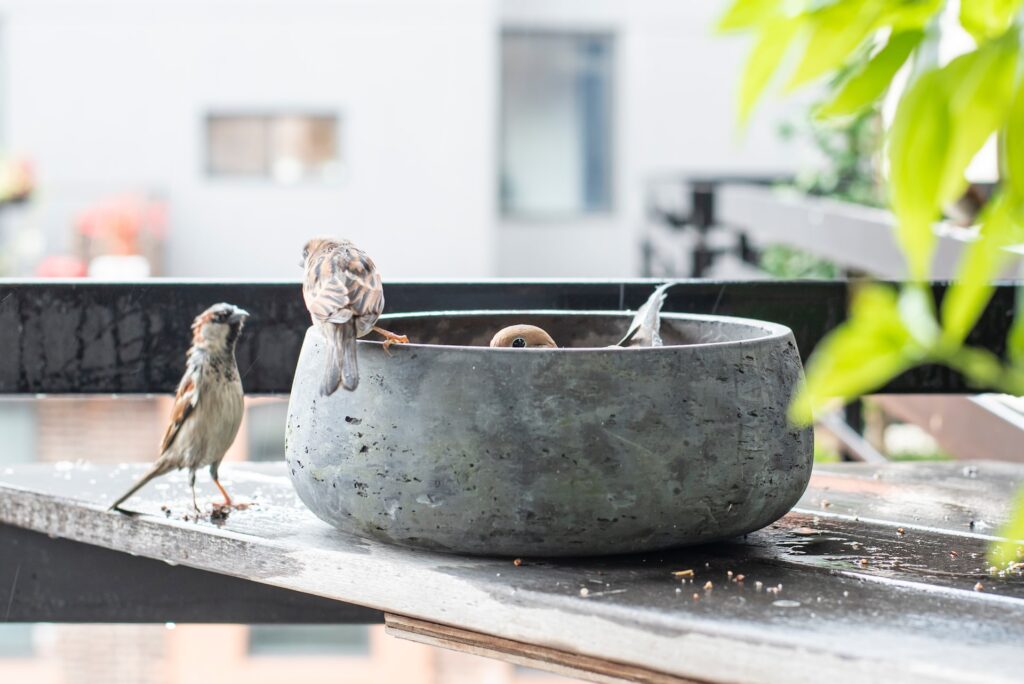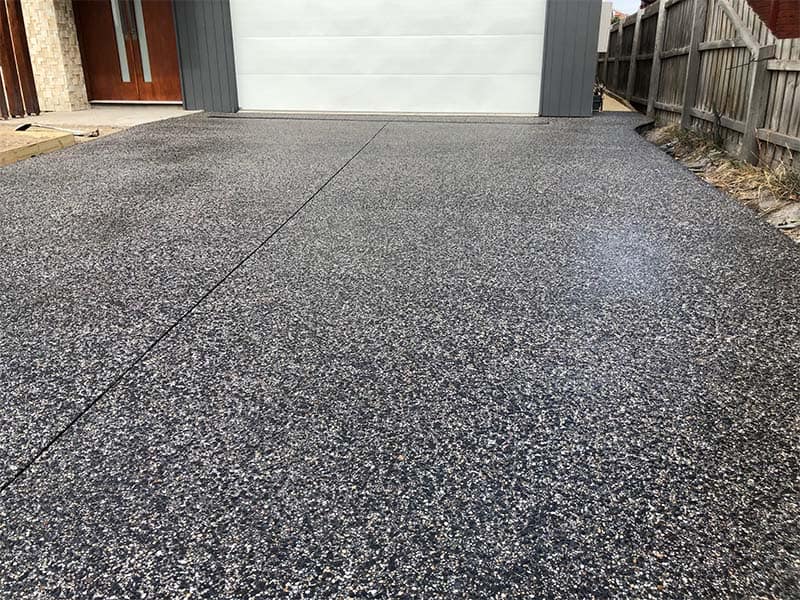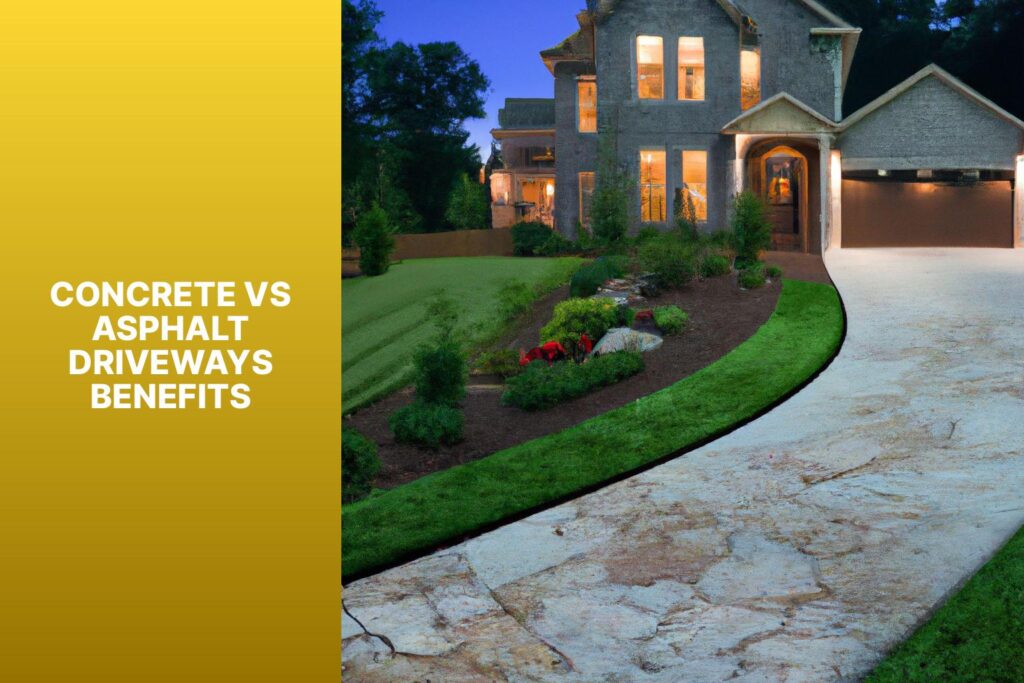Welcome to our comprehensive guide on the longevity of painted concrete patios! Whether you’re considering upgrading your outdoor space with a fresh coat of paint or you’re already enjoying the aesthetic benefits of a beautifully painted patio, understanding how long you can expect it to last is crucial. In this article, we’ll delve into the factors that affect the durability of a painted concrete patio, provide maintenance tips to extend its lifespan and offer expert advice to ensure you get the most out of your investment. By the end, you’ll have a clear picture of what to expect and how to keep your patio looking pristine for years to come.
A painted concrete patio typically lasts between 3 to 5 years with proper maintenance and care. Factors such as the quality of paint, surface preparation, application techniques, and environmental conditions can influence its durability. Regular cleaning, sealing, and timely repairs can extend the life of your painted patio, ensuring it remains beautiful and functional for longer.
- Understanding Painted Concrete Patios
- Factors Affecting The Longevity Of A Painted Concrete Patio
- Average Lifespan Of A Painted Concrete Patio
- Maintenance Tips To Extend The Life Of Your Painted Concrete Patio
- Signs It’s Time To Repaint Or Replace Your Painted Concrete Patio
- Expert Advice And Recommendations
- FAQs: About How Long Does A Painted Concrete Patio Last
- How long does a painted concrete patio typically last?
- What factors affect the longevity of a painted concrete patio?
- What type of paint is best for concrete patios?
- How should I prepare the concrete surface before painting?
- Can I paint my concrete patio myself, or should I hire a professional?
- How often should I clean my painted concrete patio?
- Is it necessary to seal a painted concrete patio?
- What should I do if the paint starts to peel or crack?
- How does weather affect the longevity of a painted concrete patio?
- When should I consider repainting or replacing my painted concrete patio?
- Conclusion
Understanding Painted Concrete Patios
Definition: What is a Painted Concrete Patio?
A painted concrete patio is an outdoor surface made from concrete that has been treated with a specific type of paint to enhance its appearance and durability. This involves applying a layer of paint or stain to the concrete surface, which not only gives it a fresh look but also protects it from the elements. Painted concrete patios are popular for their ability to transform dull, grey slabs into vibrant, attractive spaces that complement the overall design of a property.
Benefits: Aesthetic Appeal, Versatility in Design, Cost-Effectiveness
Aesthetic Appeal: One of the most significant benefits of painted concrete patios is their aesthetic appeal. With a wide range of colors and finishes available, homeowners can choose a look that perfectly matches their personal style and the existing décor of their outdoor space. Whether you prefer bold, bright hues or subtle, natural tones, painted concrete can provide a striking appearance that enhances the beauty of your patio.
Versatility in Design: Painted concrete patios are incredibly versatile when it comes to design. The paint can be applied in various patterns, such as geometric shapes, stripes, or even intricate stenciled designs, allowing for endless creativity. Additionally, different techniques like sponging, rag rolling, or stamping can be used to create unique textures and effects that mimic more expensive materials like stone or tile.
Cost-Effectiveness: Compared to other patio materials like natural stone, brick, or pavers, painted concrete is a cost-effective option. The initial cost of concrete is relatively low, and the process of painting or staining is more affordable than installing alternative materials. Moreover, the durability and low maintenance requirements of painted concrete mean that it will last for many years without needing frequent repairs or replacements, further saving money in the long run.
Common Uses: Residential Backyards, Garden Paths, Commercial Spaces
Residential Backyards: Painted concrete patios are a popular choice for residential backyards. They provide a smooth, comfortable surface for outdoor activities and gatherings, and their customizable nature allows homeowners to create a patio that reflects their personal taste. Whether it’s a vibrant, fun space for family barbecues or a serene, elegant area for relaxing painted concrete can be tailored to suit any backyard.
Garden Paths: In addition to patios, painted concrete is also an excellent material for garden paths. Its durability ensures that it can withstand foot traffic and exposure to the elements, while its aesthetic flexibility allows for the creation of paths that enhance the beauty of the garden. Painted concrete paths can be designed to blend seamlessly with the surrounding landscape, adding both functionality and visual appeal to the garden.
Commercial Spaces: Painted concrete patios are not just for residential use; they are also widely used in commercial spaces. Restaurants, cafes, and retail stores often utilize painted concrete for their outdoor seating areas and walkways. The ability to customize the look to match the branding and atmosphere of the business makes painted concrete an attractive option for commercial applications. Its durability and ease of maintenance are additional benefits that make it ideal for high-traffic areas.
In conclusion, painted concrete patios offer a versatile, attractive, and cost-effective solution for enhancing outdoor spaces. Whether used in residential backyards, garden paths, or commercial settings, their ability to transform and protect concrete surfaces makes them a popular choice among homeowners and business owners alike.
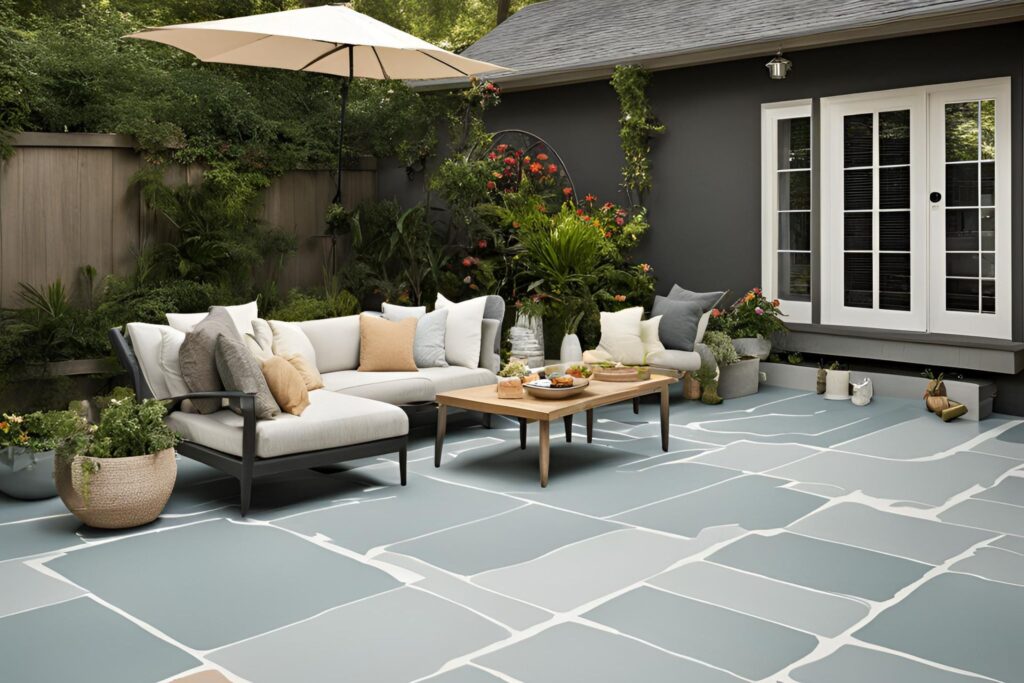
Factors Affecting The Longevity Of A Painted Concrete Patio
When it comes to maintaining a painted concrete patio, several factors can influence how long the paint job lasts. By understanding these factors, homeowners can make informed decisions to ensure their patios remain vibrant and protected over time.
Quality of Paint
Choosing the right type of paint is crucial for the longevity of a painted concrete patio. Not all paints are suitable for concrete, and selecting the appropriate one can make a significant difference.
Types of Paint Suitable for Concrete
For concrete surfaces, epoxy-based paints and acrylic paints are often recommended. Epoxy paints provide a tough, durable finish that can withstand heavy foot traffic and harsh weather conditions. Acrylic paints, on the other hand, are known for their flexibility and resistance to UV rays, which help prevent cracking and fading.
Importance of Using High-Quality, Durable Paint
Investing in high-quality paint is essential. Durable paints not only adhere better to the concrete surface but also offer better resistance to wear and tear. Cheap paints may save money upfront but often require frequent touch-ups and repaints, leading to higher costs in the long run. High-quality paints also provide better protection against environmental factors, enhancing the overall lifespan of the paint job.
Surface Preparation
Proper surface preparation is key to ensuring the paint adheres well and lasts longer. Skipping or rushing through this step can lead to premature peeling and chipping.
Steps Involved in Preparing the Concrete Surface
1. Cleaning: Remove any dirt, grease, or old paint from the surface using a pressure washer or a stiff brush and a suitable cleaner.
2. Repairing: Fill in any cracks or holes with a concrete patching compound. Allow it to dry completely.
3. Etching: Use a concrete etcher to create a rough texture, which helps the paint adhere better.
4. Priming: Apply a primer designed for concrete surfaces. This step is crucial as it creates a bonding layer between the concrete and the paint.
Impact of Proper Preparation on the Paint’s Longevity
A well-prepared surface ensures that the paint adheres properly, reducing the chances of peeling and chipping. It also helps the paint to endure various weather conditions and foot traffic, ultimately extending the life of the paint job.
Application Technique
How the paint is applied can also affect its longevity. Proper techniques can make a significant difference in the durability and appearance of the painted patio.
Best Practices for Applying Paint to Concrete
1. Follow Manufacturer Instructions: Always read and follow the paint manufacturer’s instructions regarding application methods and drying times.
2. Use the Right Tools: Utilize high-quality brushes or rollers designed for concrete surfaces to ensure even application.
3. Apply Multiple Coats: Apply at least two coats of paint, allowing each coat to dry completely before applying the next.
4. Seal the Surface: After the final coat of paint has dried, apply a concrete sealer to protect the paint from moisture and wear.
Common Mistakes to Avoid
Skipping Primer: Not using a primer can result in poor paint adhesion and a shorter lifespan.
Applying Thick Coats: Thick layers of paint can lead to uneven drying and peeling. Apply thin, even coats instead.
Painting in Extreme Conditions: Avoid painting in very hot, cold, or humid conditions, as these can affect the drying and curing process.
Environmental Factors
The environment plays a significant role in the durability of painted concrete. Understanding how different weather conditions impact the paint can help in taking preventive measures.
Effects of Weather Conditions
Sun Exposure: Prolonged exposure to direct sunlight can cause the paint to fade and deteriorate. UV-resistant paints can help mitigate this issue.
Rain and Snow: Moisture can seep into the concrete and cause the paint to peel and crack. A good-quality sealer can provide a protective barrier against moisture.
Temperature Fluctuations: Extreme temperature changes can cause the concrete to expand and contract, leading to cracking and peeling of the paint.
How Climate Can Impact the Durability of Painted Concrete
In areas with harsh climates, it is crucial to choose paints and sealers designed to withstand specific environmental challenges. Regular maintenance, such as cleaning and resealing, can also help extend the life of the painted surface.
By paying attention to these factors and taking the necessary precautions, homeowners can ensure their painted concrete patios remain beautiful and durable for years to come.
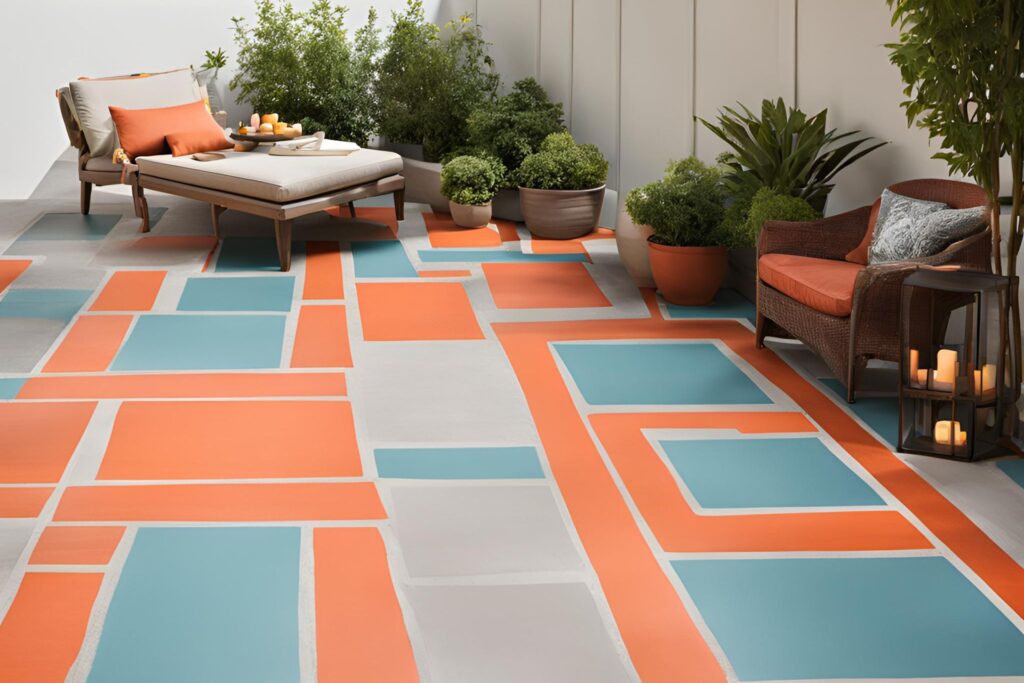
Average Lifespan Of A Painted Concrete Patio
General Lifespan
A painted concrete patio is a popular choice for homeowners due to its durability and aesthetic appeal. On average, a painted concrete patio can last anywhere from 5 to 10 years before it may need a touch-up or a new coat of paint. The longevity of the paint job depends on various factors such as the quality of the paint used, the level of exposure to harsh weather conditions, and the amount of foot traffic the patio endures.
When compared to other patio materials, painted concrete holds its own in terms of durability. Wooden patios, for instance, typically require more frequent maintenance and may need refinishing or repainting every 2 to 3 years. Stone patios, while extremely durable, can also suffer from wear and tear and may require periodic sealing to maintain their appearance. Painted concrete offers a middle ground, providing a balance of low maintenance and long-lasting appeal.
Case Studies
Real-life examples and insights from homeowners and experts highlight the practical longevity of painted concrete patios.
Case Study 1: The Thompson Residence
The Thompsons, a family from Auckland, decided to paint their concrete patio five years ago. Using high-quality epoxy paint, they have found that their patio still looks as good as new with minimal signs of wear. Mr. Thompson shares, “We were worried about how the paint would hold up, especially with our kids constantly running around, but it’s been incredibly resilient.”
Case Study 2: Expert Insight from John Mason, Patio Specialist
John Mason, a seasoned patio specialist with over 20 years of experience, states, “The key to a long-lasting painted concrete patio is all in the preparation and the type of paint used. Properly cleaning and priming the surface before applying a durable exterior paint can significantly extend the lifespan of the patio.”
Case Study 3: The Johnson Family
The Johnsons, living in Wellington, have had their concrete patio painted for eight years. They opted for a UV-resistant paint, considering the high sun exposure in their area. Mrs. Johnson remarks, “It’s amazing how well the paint has held up. We have only had to do minor touch-ups over the years, and it still looks vibrant and fresh.”
These examples underscore the importance of choosing the right materials and following proper maintenance practices to maximize the lifespan of a painted concrete patio. By investing in high-quality paint and regular upkeep, homeowners can enjoy a beautiful and durable patio for many years.
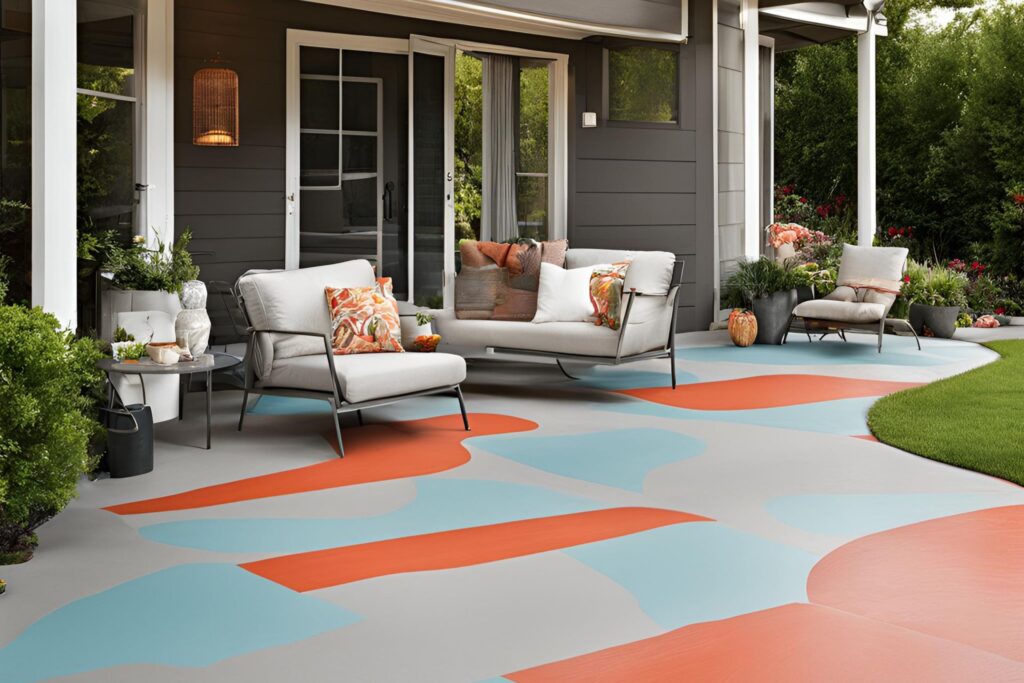
Maintenance Tips To Extend The Life Of Your Painted Concrete Patio
Maintaining a painted concrete patio involves a few essential steps that can significantly extend its lifespan and keep it looking fresh and vibrant. Here are some practical tips to ensure your patio remains in top condition for years to come.
Regular Cleaning
Recommended Cleaning Methods and Frequency
Regular cleaning is crucial for maintaining the appearance and durability of your painted concrete patio. Aim to sweep your patio at least once a week to remove debris and prevent dirt from accumulating. For a deeper clean, use a garden hose or a pressure washer on a low setting once a month. This helps to remove any built-up grime and stains that sweeping alone cannot address.
Products to Use and Avoid
When cleaning your patio, opt for mild, non-abrasive cleaners. A mixture of water and a gentle dish soap works well for most cleaning needs. For tougher stains, a solution of water and white vinegar can be effective. Avoid harsh chemicals, such as bleach or ammonia, as they can damage the paint and concrete surface. Additionally, steer clear of abrasive scrubbers that could scratch the paint.
Sealing the Surface
Benefits of Applying a Sealant
Sealing your painted concrete patio offers several benefits, including enhanced protection against water damage, stains, and UV rays. A good sealant acts as a barrier, preventing moisture from seeping into the concrete, which can cause cracks and peeling. It also helps to maintain the color and finish of the paint, keeping your patio looking fresh and new.
How Often to Reapply Sealant for Maximum Protection
To ensure maximum protection, it’s recommended to reapply the sealant every 1-3 years, depending on the wear and tear your patio experiences. High-traffic areas might require more frequent reapplication. Always follow the manufacturer’s instructions for the best results.
Repairing Damage
Identifying Common Issues (Cracks, Peeling Paint)
Over time, your painted concrete patio may develop minor issues such as cracks or peeling paint. Regularly inspect your patio for any signs of damage. Small cracks can quickly turn into larger problems if left untreated, and peeling paint can detract from the overall appearance of your patio.
DIY Repair Tips and When to Call a Professional
For small cracks and peeling paint, you can perform some DIY repairs. Clean the damaged area thoroughly, apply a concrete patch or filler for cracks, and repaint the area if necessary. For peeling paint, gently scrape away the loose paint, sand the edges, and repaint. However, if you notice significant damage or structural issues, it’s best to call a professional to assess and repair the problem to ensure it is addressed correctly and safely.
Seasonal Care
How to Protect Your Patio in Different Seasons
Each season brings unique challenges for your painted concrete patio. In spring and summer, focus on removing any accumulated debris from winter and applying a fresh coat of sealant if needed. During autumn, clear fallen leaves regularly to prevent staining and moisture buildup.
Tips for Winterizing and Summer Maintenance
Winterizing your patio is crucial to protect it from harsh weather. Before the first frost, ensure your patio is clean and apply a sealant if you haven’t done so recently. Cover your patio furniture to prevent damage, and avoid using de-icing salts directly on the concrete, as they can cause damage. In summer, regular cleaning and sealing are key to protecting your patio from UV damage and frequent use.
By following these maintenance tips, you can significantly extend the life of your painted concrete patio, keeping it looking beautiful and functional for many years. Regular care and attention will help prevent minor issues from becoming major problems, ensuring your patio remains a valuable and enjoyable part of your outdoor space.
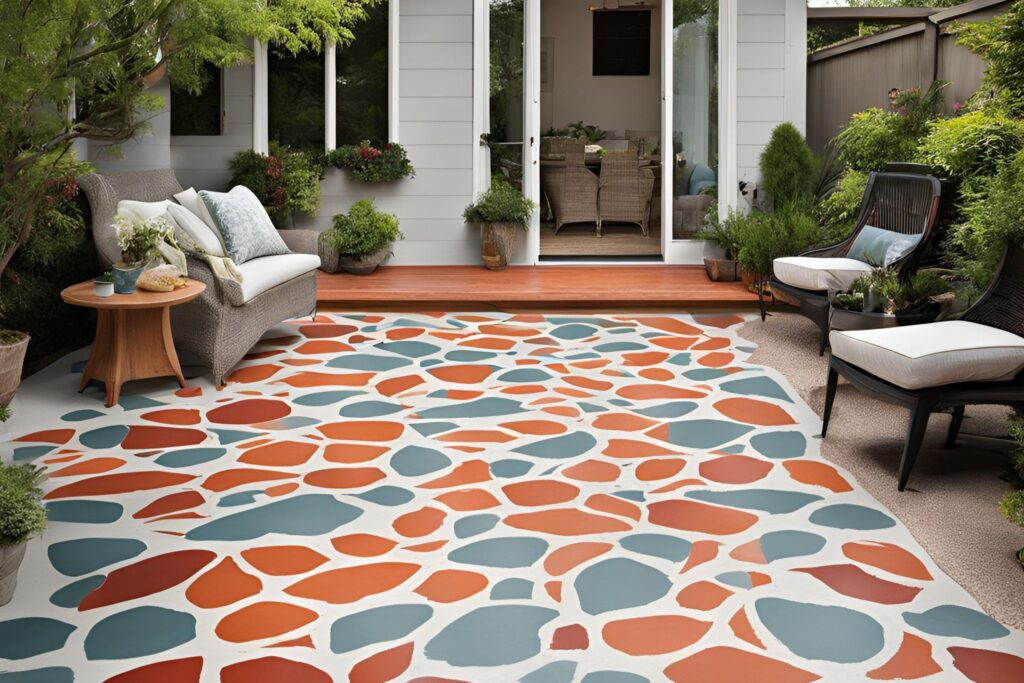
Signs It’s Time To Repaint Or Replace Your Painted Concrete Patio
Your painted concrete patio is a great asset to your outdoor living space, providing both aesthetic appeal and functional benefits. However, over time, even the most well-maintained patios can show signs of wear and tear. Knowing when it’s time to repaint or replace your painted concrete patio can save you time, money, and effort in the long run. Here are the key indicators and decision-making factors to help you make the best choice.
Common Indicators
Fading Colors
One of the first signs that your painted concrete patio needs attention is the fading of colors. Exposure to the elements, such as UV rays from the sun, rain, and fluctuating temperatures, can cause the paint to lose its vibrancy. If your patio no longer looks as bright and colorful as it once did, it’s a clear sign that a repaint might be necessary.
Visible Wear and Tear
Visible wear and tear on your patio is another indicator that maintenance is required. This can include cracks, chips, and scratches on the surface. Over time, foot traffic, furniture movement, and natural weathering can lead to these imperfections. If these signs of wear are becoming more noticeable, it might be time to consider either repainting or replacing the patio.
Peeling Paint
Peeling paint is a significant indicator that your patio needs attention. Paint can start to peel due to poor adhesion, exposure to moisture, or simply the age of the paint job. Peeling not only looks unsightly but also exposes the concrete beneath to further damage. If you notice large areas of peeling paint, it’s a clear sign that action is needed soon.
Decision-Making Guide
Assessing Whether to Repaint or Replace the Patio
When deciding whether to repaint or replace your painted concrete patio, start by assessing the extent of the damage. For minor issues like fading colors or small areas of wear and tear, repainting might be the most cost-effective and straightforward solution. Repainting can refresh the look of your patio and provide an additional protective layer to the concrete.
However, if the damage is extensive, such as large cracks, significant peeling, or structural issues, replacing the patio might be the better long-term solution. Replacing ensures that the new surface is free from underlying problems and can be a more durable option.
Cost Considerations and Long-Term Benefits
Cost is a crucial factor in your decision-making process. Repainting a patio is generally less expensive than replacing it. The cost of paint, tools, and labor for repainting is typically lower compared to the materials and labor required for a complete replacement.
However, consider the long-term benefits. A newly replaced patio, while initially more costly, can offer greater durability and potentially reduce maintenance costs in the future. It can also increase the overall value of your property.
In summary, keeping an eye out for common indicators such as fading colors, visible wear and tear, and peeling paint will help you determine when your painted concrete patio needs attention. By carefully assessing the extent of the damage and weighing the cost considerations and long-term benefits, you can make an informed decision on whether to repaint or replace your patio. Taking timely action will ensure that your outdoor space remains attractive and functional for years to come.
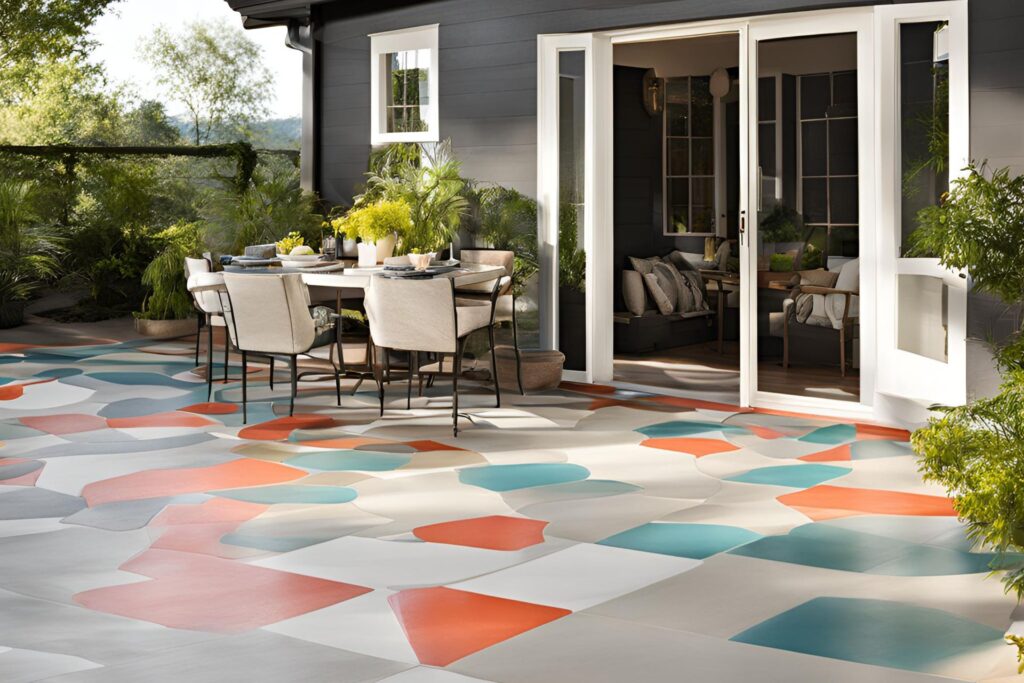
Expert Advice And Recommendations
Interviews with Professionals
Insights from Painters, Contractors, and Landscapers
When it comes to painting your concrete patio, insights from industry experts can be invaluable. Painters, contractors, and landscapers bring a wealth of experience and practical knowledge that can make your project successful. Here are some key takeaways from these professionals:
1. Painters: Professional painters emphasize the importance of surface preparation. Before applying any paint, ensure your patio is clean and free of any debris, oils, or old paint. This might involve power washing and using specialized cleaners. Painters also suggest using high-quality primers that are specifically designed for concrete surfaces. These primers help the paint adhere better and last longer.
2. Contractors: Contractors highlight the significance of choosing the right type of paint. Epoxy-based paints are often recommended due to their durability and resistance to wear and tear. Contractors also advise applying multiple coats and allowing sufficient drying time between each coat to ensure a robust finish.
3. Landscapers: Landscapers add that the surrounding environment should be considered. For example, if your patio is exposed to a lot of sunlight, UV-resistant paints are crucial to prevent fading. They also suggest incorporating sealants to protect the painted surface from moisture and other environmental factors.
Best Practices for Ensuring a Long-Lasting Painted Patio
To achieve a long-lasting painted patio, follow these best practices:
Surface Preparation: Thoroughly clean and prep the concrete surface to remove any contaminants. This can include power washing, scrubbing, and using a concrete cleaner.
Primer Application: Use a high-quality primer suitable for concrete surfaces to improve paint adhesion and longevity.
Choose the Right Paint: Opt for epoxy or acrylic paints that are designed for outdoor concrete surfaces. These types of paint offer better durability and resistance to environmental factors.
Multiple Coats: Apply multiple thin coats of paint rather than one thick coat. This ensures better coverage and a more durable finish.
Sealant Use: Once the paint is dry, apply a clear sealant to protect the paint from moisture, UV rays, and general wear and tear.
Regular Maintenance: Regularly inspect your painted patio and touch up any areas showing signs of wear. Cleaning the patio periodically will also help maintain its appearance and durability.
Recommended Products
Top-Rated Paints and Sealants for Concrete Patios
Selecting the right products is crucial for a successful patio painting project. Here are some top-rated paints and sealants recommended by professionals:
Epoxy Paints: Known for their durability, epoxy paints are ideal for high-traffic areas like patios. They offer excellent adhesion, resistance to wear and tear, and a long-lasting finish.
Acrylic Paints: These are flexible and UV-resistant, making them suitable for outdoor use. Acrylic paints are also easy to apply and maintain.
Concrete Sealants: Clear sealants protect the painted surface from moisture, UV rays, and stains. They enhance the durability of the paint and keep your patio looking fresh for longer.
Tools and Equipment for DIY Enthusiasts
For those who prefer to tackle the project themselves, having the right tools and equipment is essential. Here’s what you’ll need:
Power Washer: To thoroughly clean the patio surface before painting.
Concrete Cleaner: To remove any stubborn stains or contaminants.
Paint Rollers and Brushes: For applying primer, paint, and sealant evenly. Use rollers for larger areas and brushes for edges and corners.
Paint Sprayer: For a more professional and even finish, especially on larger surfaces.
Protective Gear: Gloves, masks, and goggles to protect yourself from fumes and splashes.
Painter’s Tape: To protect areas you don’t want to be painted, such as edges and surrounding structures.
By following expert advice and using recommended products and tools, you can ensure a beautifully painted concrete patio that stands the test of time.

FAQs: About How Long Does A Painted Concrete Patio Last
How long does a painted concrete patio typically last?
A painted concrete patio generally lasts between 3 to 5 years with proper maintenance and care. The lifespan can be extended by using high-quality paint and following recommended maintenance practices.
What factors affect the longevity of a painted concrete patio?
The longevity of a painted concrete patio is influenced by the quality of paint used, surface preparation, application techniques, and environmental factors such as weather conditions.
What type of paint is best for concrete patios?
Epoxy and acrylic paints are commonly recommended for concrete patios due to their durability and resistance to weather conditions. High-quality, outdoor-specific paints provide the best results.
How should I prepare the concrete surface before painting?
Proper surface preparation includes cleaning the concrete thoroughly, repairing any cracks or damage, and applying a primer. This ensures better adhesion and longevity of the paint.
Can I paint my concrete patio myself, or should I hire a professional?
While painting a concrete patio can be a DIY project, hiring a professional ensures proper surface preparation and application, which can significantly extend the lifespan of the paint.
How often should I clean my painted concrete patio?
Regular cleaning every few months with mild detergent and water is recommended to remove dirt, debris, and stains. Avoid using harsh chemicals that can damage the paint.
Is it necessary to seal a painted concrete patio?
Yes, applying a sealant can protect the paint from moisture, UV rays, and wear and tear. It’s recommended to reseal the patio every 1 to 2 years for maximum protection.
What should I do if the paint starts to peel or crack?
If the paint begins to peel or crack, clean the affected area, sand it down to remove loose paint, and apply a new coat of paint. For extensive damage, consider repainting the entire patio.
How does weather affect the longevity of a painted concrete patio?
Extreme weather conditions, such as excessive sun exposure, heavy rain, and freezing temperatures, can impact the durability of the paint. Using weather-resistant paint and sealant can mitigate these effects.
When should I consider repainting or replacing my painted concrete patio?
Consider repainting when the paint shows significant wear, fading, or damage. If the concrete itself is damaged or the patio’s overall condition is poor, replacement might be a better option.
Conclusion
In conclusion, it’s crucial to remember the key points we’ve discussed: understanding the importance of choosing quality materials, ensuring proper installation, and committing to regular maintenance for long-term durability. Investing in these aspects not only enhances the aesthetic appeal and functionality of your project but also saves you money in the long run by reducing repair costs. We encourage you to prioritize quality and upkeep in your projects, as these investments pay off significantly over time. Feel free to share your experiences or ask any questions in the comments section below—we’d love to hear from you and help with any concerns you might have.
About the Author:
Mike Veail is a recognized digital marketing expert with over 6 years of experience in helping tradespeople and small businesses thrive online. A former quantity surveyor, Mike combines deep industry knowledge with hands-on expertise in SEO and Google Ads. His marketing strategies are tailored to the specific needs of the trades sector, helping businesses increase visibility and generate more leads through proven, ethical methods.
Mike has successfully partnered with numerous companies, establishing a track record of delivering measurable results. His work has been featured across various platforms that showcase his expertise in lead generation and online marketing for the trades sector.
Learn more about Mike's experience and services at https://theleadguy.online or follow him on social media:
